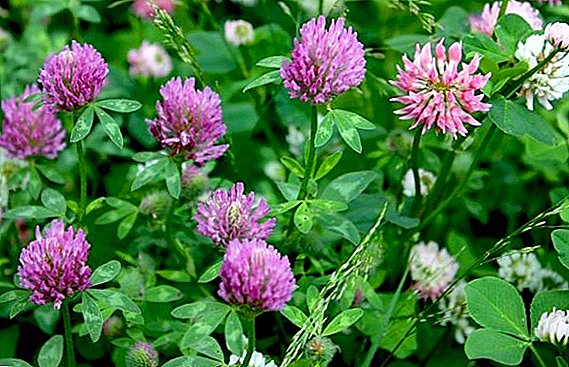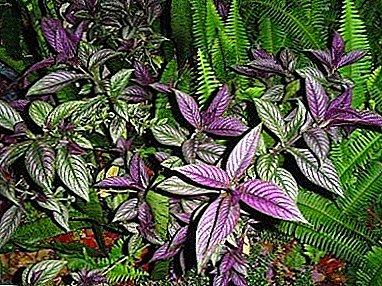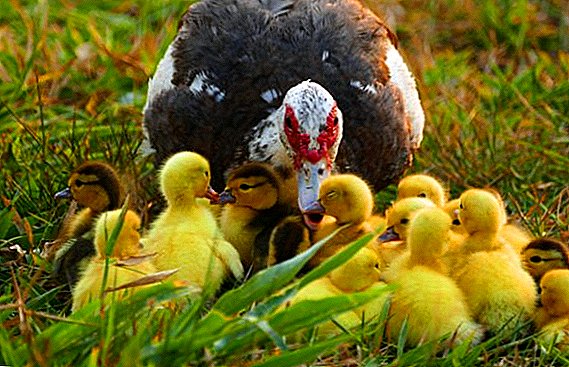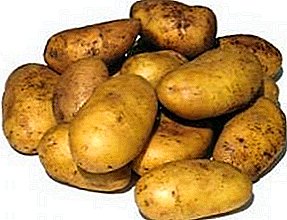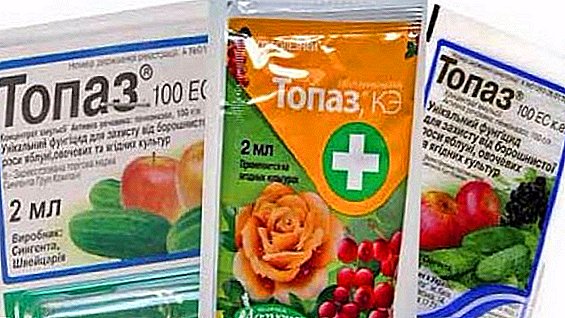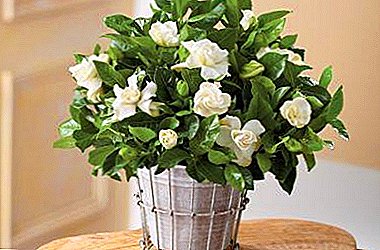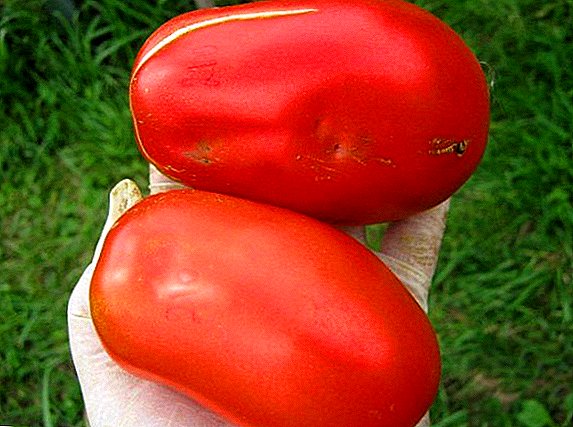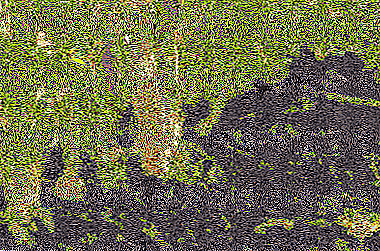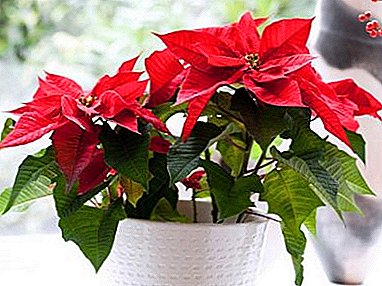
Did you know that the symbol of the New Year and Christmas is not only the Christmas tree and tangerines? The poinsettia ornamental houseplant also belongs to their number! In addition to this name, at the hearing you may have the following: "Bethlehem Star", "Euphorbia beautiful", "Christmas Star", "Poinsettia is beautiful", and all these names combine one tropical plant.
Such different in content names went from the appearance. Bright leaves collected on the top in the form of a star, at first glance resemble flowers that are not. Leaves become colored during the Christmas period. When some parts of the plant are damaged, milk juice is released. And the final name of the poinsettia, the flower was in honor of the botanist who discovered it and later began to select it.
Characteristics and varieties
 In the wild, it is a shrub that reaches 3 meters in height. It belongs to the family of Molochai, their the main distinguishing feature is the release of poisonous milk juice when damaged. In the past, poisonous milk was used for medicinal purposes and for the manufacture of certain drugs, and bright leaves - for dyeing fabrics and cosmetic purposes!
In the wild, it is a shrub that reaches 3 meters in height. It belongs to the family of Molochai, their the main distinguishing feature is the release of poisonous milk juice when damaged. In the past, poisonous milk was used for medicinal purposes and for the manufacture of certain drugs, and bright leaves - for dyeing fabrics and cosmetic purposes!
This flower belongs to the evergreen representatives! Growing at home is a small bush, about 40 cm high, is a fluffy cap of rich green leaves, serrated to the edges.
You can also find a different color of leaves - two-color. In this case, saturated green leaves to the edge yellowed, as if dried, but this color does not spoil the appearance. On the top of the caps are formed yellow sockets, which are surrounded by red leaves - these are the so-called flowers!
Domestic representatives are usually annuals, maximum two years old.
The flowering period is very short, from 2 to 6 weeks, falls on a cold period of time, the Christmas holidays!
By the end of flowering, the plant drops all the leaves and becomes completely naked.from that moment on it hibernates, but this does not mean that it has died. It is likely that by next winter it will again delight you with its charming beauty!
In the wild, the most common poinsettia is one that has a bright fiery color. But time does not stand still, and new varieties with different shades were bred by the breeders. There are both plain representatives and variegated.
Variegated
Sonora marble
A photo:

Cream beauty owner of an ivory shade interspersed in the middle of a pink shade.
Winter blur marble
A photo:

Surprised by non-standard color solution of leaves. The crown has a soft pink color with a milky edging surrounded by leaves of grass color.
Strawberry and cream
A photo:

Unreal beautiful "marble" view. Interlacing soft white spots with a coral shade of foliage.
Da vinci
A photo:

Amazing view, striking in its beauty. Non-standard color solution in the style of "pink flamingo".
Monet twilight
A photo:

A winner of creamy colors with a blurry pink shade., as if stained with scarlet paint.
Tapestry
A photo:

Chic variety, a characteristic feature of which are heart-shaped leaves of rich scarlet color.
Yellow and orange representatives
Lemon snow
A photo:

The owner of a pale lemon color.
Cinnamon star
A photo:

Representatives of this variety have leaf color. An amazing combination of orange color, smoothly turning into rich yellow, which passes to the leaves with green veins. A distinctive feature of this type is sharp, jagged leaves.
Orange poincettias
A photo:

The elongated leaves of this variety have a rich orange color.
Yellow poincettias
A photo:

Representatives of this species have all the shades of pistachio color.
Euphorbia pulcherrima
A photo:

The owner of a fiery shade. The color range of leaves smoothly changes from rich yellow to fiery orange.
White Leaf Holders
White star
A photo:

The name itself speaks of itself! The elongated pointed leaves of pearl beige color, gathered in a bouquet resemble huge stars!
Polar bear
A photo:

Representatives of this species resemble a piece of iceberg in their color.. The core of the flower has a yellow tint with a slight green.
Arctic white
A photo:

Cold white flowers on the background of saturated green leaves will not leave anyone indifferent.
All shades of red
Tapestry
A photo:

Amazing sotr who fascinates with its beauty. The flowers are saturated with fiery scarlet color, and the leaves that grow along the shoot are two-colored, with yellow spraying on the edges.
Carousel red
A photo:

Very unusual species! A distinctive feature of which is in the open edges of the inflorescence of a rich red color, which differs from the leaves themselves.
Carousel dark red
A photo:

Very similar to the previous form, especially in the structure and shape of the flower, only the shade has a dark scarlet.
Premium Red
A photo:

This is a classic among all varieties.. It is a lush bright red inflorescence in the middle of the crown. The core is standard yellowish green.
Cortez burgundy
A photo:

The representative of a rich burgundy hue with a traditional heart-shaped form of the petal.
Other varieties
Blue poinsettia
A photo:

This view has a fascinating beauty! The colors are electric electric. and combined with rich green leaves, which are painted with uneven dark veins.
Eckespoint lilo
A photo:

Very custom color solution for poinsettia. Purple flowers with a lilac sheen.
Strawberry and cream
A photo:

Themselves petals are very unusual shape, like a maple leaf. The color scheme is very delicate, the creamy pink color of the petal in the middle is blurred with a milky shade.
Polly pink
A photo:

The brightest representative of pink! The leaves are deep pink.
Prestige maroon
A photo:

The Poinsetti Queen! The rich, noble wine shade of burgundy color in combination with dark emerald leaves gives this variety a regal look.
Care rules
As with any ornamental plant, poinsettia also needs care for normal life. After all, timely watering, proper location, good soil are all elements of care that affect the appearance of any plant.
- Pot. Properly chosen capacity plays a big role in the existence of the plant. It is very important for the poinsettia material of which the pot is made, she prefers either ceramics or plastic.
When choosing a pot should take into account the size of the root system of the flower and already from this come. The roots should not be compressed, but the excess space also does not bode well, since development will be concentrated to the root.
- The soil. When transplanting or planting choose a loose, fluffy soil. This is necessary for it to be well enriched with oxygen and evenly pass water during irrigation.Pay attention to the acidity of the earth. It should include: turf and leaf land, peat, and river sand.
- Watering. A key component in the care of plants. Watering should be moderate. In the period of spring and summer, it is enough to water the plant a couple of times a week, but with the onset of autumn it should be reduced to several times a month. Water only need to pre-settled water.
- Location. With the location of the poinsettia is worth the trouble! In the period from autumn to winter, inclusive, it should be located on the south side, closer to the sun, but in spring and summer it should be relocated from the south side. During this period, the sun's rays are merciless and can cause sunburn on the foliage! Avoid direct sunlight.
- Top dressing. From fertilizer depends on the appearance and general condition of the flower. Feed needs in spring and summer, as a mineral complex, and organic. Two times a month is enough!
Variations of feeding alternate, it contributes to better assimilation of useful components. The concentration of feeding must be performed with all the requirements of the instructions, otherwise the plant may get burned.
- Air temperature and humidity. Since southern Mexico is homeland, the climatic conditions speak for themselves! This is a very thermophilic plant, which is detrimental to the sharp decline in temperature. The ideal temperature for the flower is from +25 to +18 degrees. If the temperature falls below + 15 the flower may die.
Since the flower is of tropical origin, it prefers higher humidity. Particular attention should be paid to this issue during the winter period, when heating devices work intensively and during the heat of the summer heat.
You can easily cope with this nuance by spraying the air around the plant, but avoiding contact with the flower itself.
Water on the leaves will spoil their appearance by the formation of yellow spots.
Another alternative solution to the problem of air humidity is to place a container with water near the poinsettia. This will maintain the necessary moisture balance.
Interesting video about the secrets of flower care:
Christmas star is a very unusual flower! Do not forget that this beauty is also poisonous! And the greatest amount of poison is focused in its beauty - the so-called colors! But in spite of this, it will perfectly complement your interior with beauty and bring some flavor to it!


